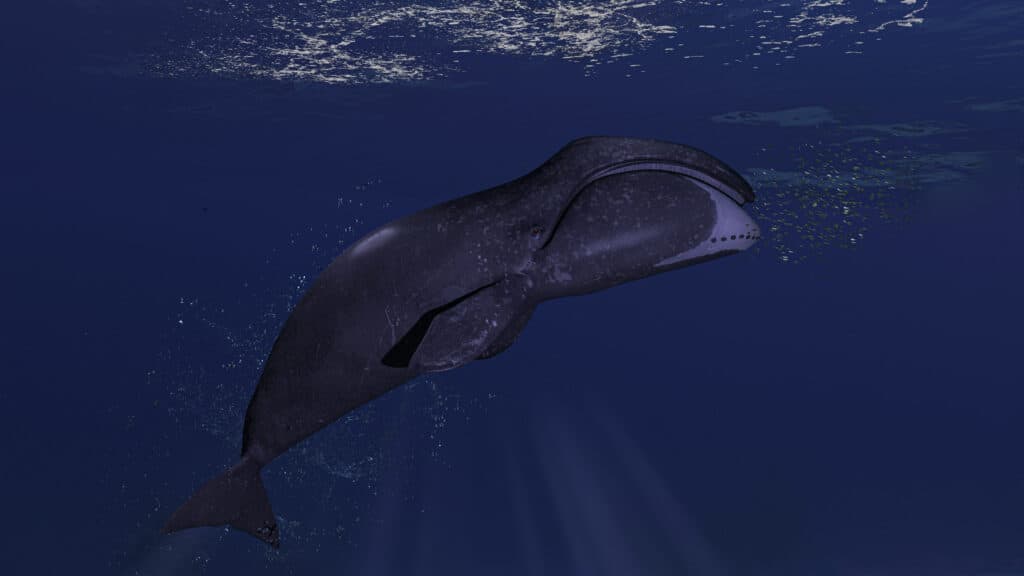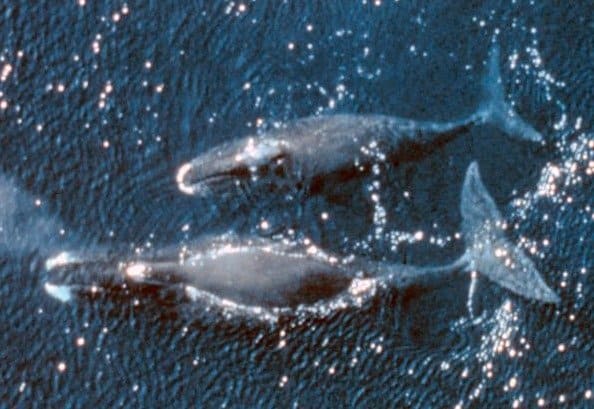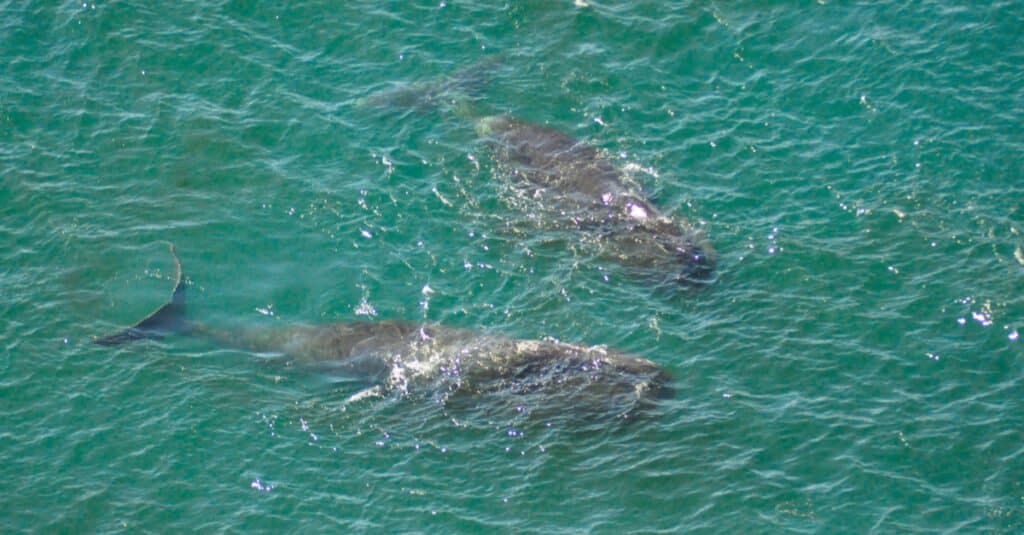Bowhead whale facts are intriguing, one of which is that these mammals inhabit the chilly waters of the Arctic and subarctic. You will see them gracefully gliding through the waters of several regions. These regions include Hudson Bay, Foxe Basin, Bering Sea, Beaufort Sea, Chukchi Sea, Davis Strait, Baffin Bay, and the Sea of Okhotsk. Beyond their habitat, enjoy reading through ten other bowhead whale facts below.
1. Bowhead Whales Have a Long Life Span and Many Names

Bowhead whales live for over 200 years and have the most enormous mouth of any whale.
©iStock.com/bbevren
Bowhead whales are the titans of the cold Arctic and subarctic waters. These whales, believed to be the longest-living mammals, live for over 200 years and have the most enormous mouth of any whale. Other than living for up to two centuries, bowhead whales also have different names. These names include Russian, Greenland right, Arctic, steeple-top, and polar whales.
2. Bowhead Whales Take Their Name From Their Skull Shape
These whales have giant triangular skulls. Bowhead whales use their large, triangular-shaped heads to push through the ocean ice to come up for air. They have a feeding system known as baleen, the largest of all whales. The bowhead whales’ baleen is 9.8 feet long, allowing them to catch and strain small prey.
3. Bowhead Whales Have Two Blowholes
Other bowhead whale fun facts include having two blowholes at the tip of their head where they spurt water. Other interesting bowhead whale facts include their dark gray skin, white chins, and lower jaws. Besides their color, their size is astounding, as they grow 50 to 60 feet long and weigh between 75 and 100 tons. The female whales are generally larger than the males. Bowhead whales have the densest fat layer of any animal, up to 20 inches thick. Unlike most whales, bowhead whales don’t have dorsal fins, allowing them to spend more time beneath the ice near the water’s surface.
4. Bowhead Whales Are Not Endangered

Bowhead whales are classified as least concern.
©NOAA Photo Library / public domain – License
These whales commonly live in the Hudson Bay, Foxe Basin, Bering Sea, Beaufort Sea, Chukchi Sea, Davis Strait, Baffin Bay, and the Sea of Okhotsk. They also live in the waters between eastern Siberia and Greenland/Spitsbergen. The range of these whales depends on how much ice forms or melts in the region. Bowhead whales venture further south during winter and northwards during springtime when the ice starts to recede or break.
Researchers are not sure what the total population of bowhead whales is but assume that between 8,000 and 12,000 individuals are left. Because of this, their conservation status is of least concern.
5. The Bowhead Whale Is a Part of Different Population Stocks
Bowhead whale interesting facts include five different population stocks:
- The Baffin Bay and the Davis Strait have one stock with roughly 14,400 whales.
- The population in the Western Arctic stock is substantial, and the number of whales in this stock is estimated to be close to the ones in pre-whaling times.
- There is a population of 500 to 600 bowhead whales in the Hudson Bay and Foxe Basin stock.
- The Svalbard-Barents Sea stock has fewer whales, and this stock has become endangered.
- The Sea of Okhotsk stock has less than 400 bowhead whales.
6. Bowhead Whales Have Few Predators
Because of their size, bowhead whales only have two main predators. These threats are people and killer whales when they work together in a pod during the attack. However, people posed the most significant threat to these whales, causing a considerable decrease in their populations when whaling was at its peak.
People hunt these whales for their meat, blubber, baleen, bones, and oil. Bowhead whales are slow swimmers and float to the surface when killed, which makes them perfect targets. First Nation people still hunt bowhead whales today. However, they are allowed to hunt these behemoths and do so in a humane, controlled fashion.
7. Specific Native American Tribes May Hunt Bowhead Whales

Some indigenous Alaskan groups hunt bowhead whales at a subsistence level.
©Vladimir Chebanov/Shutterstock.com
Hunting bowhead whales is illegal for most people, except for two native Alaskan groups. These indigenous Alaskan groups are the Iñupiat and St Lawrence Island Siberian Yupik people, who may hunt these whales at a subsistence level. Subsistence hunting means that these groups can capture these whales to support their population. These groups use the meat and fat of the bowhead whale in cooking. An example of a meal made from a bowhead whale is muktuk. Muktuk uses the skin and fat, and these Alaskan people either eat this meal raw or deep-fried.
8. Bowhead Whales Eat 2 Tons of Food a Day
Bowhead whales eat almost two tons of amphipods, crustaceans, copepods, and other zooplankton daily. These whales are filter feeders, as their mouths have hundreds of plates of baleen that overlap and filter food from the water as they swallow. Their baleen close to the tongue traps the food before they engulf their meals.
9. Bowhead Whale Calves Weigh a Ton When Born

Bowhead whale offspring weigh about 2,200 pounds when they are born.
©bekirevren/Shutterstock.com
Bowhead whale offspring are born between 13 and 15 feet long and weigh 2,200 pounds, or one ton. Calves have a thick blubber layer when they are born, which helps them to survive in the Arctic waters. These calves can also swim independently after a half hour of being born. Bowhead whales reach sexual maturity between the ages of 10 and 15.
They mate between March and August, but females are more likely to become pregnant in March when most mating occurs. Bowhead whales mate in pairs or groups with multiple males and one or two females. Female bowhead whales are pregnant for 13 to 14 months and give birth to a calf every three to four years. After the first year of life, the calf will grow to about 27 feet long and stop nursing.
Researchers believe bowhead whales are the longest-living mammals, but their exact lifespan is not known with certainty. But scientists think these mammals live for over 200 years and believe the oldest bowhead whale on record was 268. Scientists determined this age after examining the whale’s genome sequence.
10. Bowhead Whales Rely on Communication
These whales communicate via vocalizations and have various calls and complex songs. A study found that these whales have 60 unique songs at a wintering ground. The bowhead whale was the rowdiest when the water was coldest and ice was at the thickest. During this time, the ocean is the darkest, and the bowhead whales can primarily only use sound to communicate with each other.
Up Next:
The photo featured at the top of this post is © Vladimir Chebanov/Shutterstock.com
Sources
- Kidadl, Available here: https://kidadl.com/facts/animals/bowhead-whale-facts
- Oceanwide Expeditions, Available here: https://oceanwide-expeditions.com/to-do/wildlife/bowhead-whale
- OneKind Planet, Available here: https://onekindplanet.org/animal/whale-bowhead/
- Arctic Kingdom, Available here: https://arctickingdom.com/10-fun-facts-about-bowhead-whales/
Thank you for reading! Have some feedback for us? Contact the AZ Animals editorial team.






